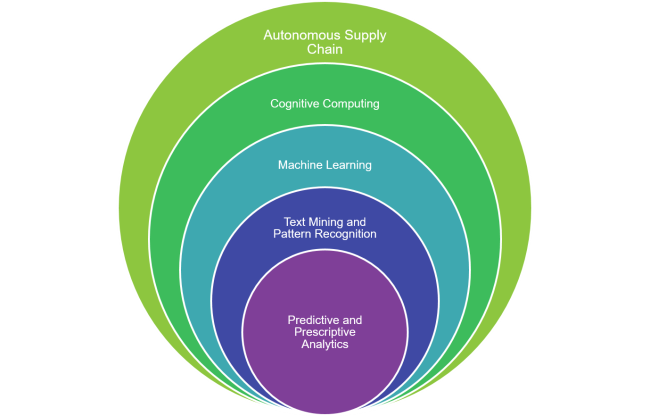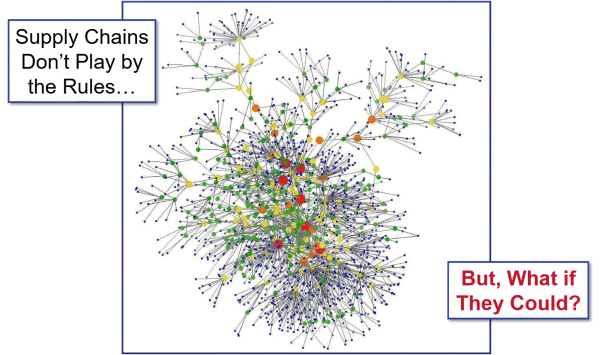 No doubt about it. The decision-support technologies that we use today–price management, trade promotion management, network design, supply chain planning, transportation planning, supplier risk management–are on the cusp of redefinition through new forms of analytics. We are on a hype cycle. There is no common definition of cognitive computing and there are many variants.
No doubt about it. The decision-support technologies that we use today–price management, trade promotion management, network design, supply chain planning, transportation planning, supplier risk management–are on the cusp of redefinition through new forms of analytics. We are on a hype cycle. There is no common definition of cognitive computing and there are many variants.
A blue ocean lies ahead. We can only imagine what this means.
Navigating the Hype Cycle of Cognitive Computing
Buyer beware. We tend to overstate the importance of new technologies in the beginning of a hype cycle and understate the value of technologies at the end of a life cycle.
A hype cycle starts with a technology trigger. In the case of cognitive computing, the trigger is the use of sensor technologies along with in-memory processing to sense, learn and act. We are witnessing the evolution of analytics for pattern recognition, and unstructured text mining along with the redefinition of architectures to enable streaming data and real-time process innovation. The work by Google on manless vehicles or the Department of Defense’s work on ‘bad guy detection’ spawned early innovation. Despite the powerful and brilliant IBM Watson marketing machine, realize that it is still early. Only 7% of manufacturers are experimenting with cognitive computing.
The peak of inflated expectations lies ahead. At this stage, hype reigns and craziness becomes the new norm. I think that this is a technology trend that is here to stay with long-lasting implications; however, my advice to technology leaders is to take it slow. We will drive more value if we slow down the hype cycle by testing and co-development with technology innovators. Realize that these technologies, while promising, are still experimental. The redefinition of decision support, and the building of adaptive rule-sets within the enterprise through cognitive computing, will take time. The longer we take, the larger the potential value. There are many powerful use cases;but use caution, they are evolving.
After the hype, realization sets in, we enter the trough of disillusionment, followed by a slope of enlightenment which leads to a plateau of productivity. This is the current state of the Enterprise Resource Planning (ERP) and Advanced Planning Systems (APS) markets .
Almost every technology conference that I attend these days has an “AI announcement.” (AI lacks a common definition. Ask each technology provider for a definition: artificial intelligence or augmented intelligence? The implication is the use of computer learning to improve decision making.) However, when push comes to shove, in Q&A most of the announcements are on pattern recognition/text mining. Here I give the reader some insights into the definitions I use in my writing. My goal is to start the dialogue to define these terms to avoid confusion. The evolution of capabilities creates confusion.
Figure 1. Evolution of Analytics in Supply Chain Management

Descriptive and predictive analytics drive the world we live in. This is our comfort zone and our paradigm. The journey starts with definitions and clarity on terms.
Getting Clear on the Definitions.
Let’s start with some definitions:
- Descriptive Analytics. These technologies enable the visualization of data for human consumption. There are many descriptive analytic technologies in the market including Arcadia, Microsoft BI, Qlik, Tableau, and Spotfire. The list could go on and on. Over the last decade, the evolution of descriptive analytics to visualize the current state dramatically improved supply chain decision making.
- Predictive Analytics. In contrast, predictive analytics enables modeling and the use of statistics to derive insights. The building of the data models is based on what we know. This is the world of statistics largely driven by the evolution of ILOG (now owned by IBM), R, SAS, and SPSS (now owned by IBM). The evolution of data modeling through predictive analytics triggered the evolution of supply chain planning, frequently termed APS. Advanced statistical modeling through the use of techniques like stochastic optimization, genetic algorithms, and Random Forest analysis drove improvements in supply chain planning in the period of 2005-2010. Predictive analytics models are largely based on data inputs from history. They are batch, and the data is usually structured in rows and columns in a relational database. The output is a recommendation and a list of exceptions to review and consider. There is no sensing.
- Prescriptive Analytics. Sensor technologies drive the evolution of prescriptive analytics. Using inputs like weather, traffic congestion, and flow sensing, the analytic output adapts to give new inputs based on the use of sensors. The outputs not only include exceptions, but a recommendation on what action to take based on the exception.
- Pattern Recognition/Text Mining. In this approach, there is no predetermined data model. The focus is learning from the data. The computer output is an analysis of the patterns. An early leader in pattern recognition was Terra Technology, now owned by E2open, that pioneered the evolution of demand sensing. SAS’s text mining applications lead in the mining of unstructured data for sentiment analysis.
- Machine Learning. When the computer learns from pattern recognition and text mining, the next evolution is machine learning. This enables insights on the patterns. Rulex, a partner of ToolsGroup, is an example of machine learning. The insights are driven by models using statistics from pattern recognition. This type of technology will transform master data management and the matching of documents.
- Cognitive Computing. In this evolution, machine learning using an ontology drives insights. (A view, or starting point, of complex interactions that are many-to-many.) This ontology uses structured and unstructured data. It is not limited to relational database technologies. Things no longer are force-fit into rows and columns. Figure 2 is an example of an ontology. The ontology is the beginning state for learning. As the computer learns, the ontology is updated. This enables new insights. The computer answers the questions that we do not know to ask through sense, learn and act workflows.
Figure 2. An Example of an Ontology

So, as you sort through the onslaught of vendor promises, ask some basic questions:
- How do you do the modeling?
- What do you use as inputs?
- Can you clarify the business problems that you solve?
After you get these answers, start to put the technologies into your own taxonomy. While many technologists are using the term AI, for many it is lipstick on an old pig.
 As we sort through these new technologies, our feet need to be grounded in reality with a focus on goals. The building of a digital innovation analytics strategy requires big feet and wings.
As we sort through these new technologies, our feet need to be grounded in reality with a focus on goals. The building of a digital innovation analytics strategy requires big feet and wings.  How so? The wings allow us to imagine the future, but the feet are grounded with a focus on today’s reality and delivering against business goals. We cannot confuse activity with progress. It takes both; and hopefully, we will not let the technology community overhype and short change one of the most promising shifts in technologies in over a decade.
How so? The wings allow us to imagine the future, but the feet are grounded with a focus on today’s reality and delivering against business goals. We cannot confuse activity with progress. It takes both; and hopefully, we will not let the technology community overhype and short change one of the most promising shifts in technologies in over a decade.
This is an inflection point for decision support technology providers. The AI presentation hype is in full force. The future is in our hands. The journey starts with clarity on definitions. Let me know what you think of these working definitions. I will mold them through input.
Join the Guiding Coalition at the Supply Chain Insights Global Summit
On a side note, don’t forget to register for the Supply Chain Insights Global Summit. We are putting the finishing touches on the agenda, and promise that the experience on September 5-8, 2017 will be a great opportunity for digital transformation leaders to ideate and imagine the supply chain of the future. The event features some cognitive computing case studies.
The event’s focus is on next-generation supply chain thinking. With attendance by 100-125 supply chain leaders, we design the event to enable learning on new technologies, ideation on process innovation, and networking with other business leaders on the future of supply chain management. Each company can send up to three supply chain leaders. We limit technology software providers to 25% of attendees.
The conference is designed to generate new ideas on next-generation supply chain thinking. During the program, together we will explore:
- Digital Supply Chain. We will answer the question of how the confluence of technologies—wearables, robotics, cognitive computing, 3D printing, real-time data and the Internet of Things (IOT), blockchain, and bitcoin—will change the future of supply chain processes and drive opportunities for a digital supply chain transformation. Don’t miss out on Unilever’s presentation on the use of cognitive computing to drive new insights on decision support; Jabil’s presentation on designing/driving digital innovation; Carter’s work on managing complexity or Fast Radius’ launch of process innovation through additive manufacturing. You will also gain insights on the Network of Networks group’s work on blockchain, along with insights on wearable/IOT to redefine digital manufacturing.
- Forge New Directions for Supply Chain 2030. In dialogue with our keynote speakers–Robert J Gordon, of Northwestern University, speaking on American productivity from past industrial revolutions, and Gita Gopinath, from Harvard, sharing insights on the rise of China and India as the global economy shifts through cycles of Nationalism and Globalization—we will forge a clearer vision of Supply Chain 2030.
- What Drives Supply Chain Excellence? As a group, we will examine the impact of supply chain strategies on balance sheet and income statements for the period of 2010-2016 and celebrate success. This work is the culmination of a six-month project that Supply Chain Insights and Cloudera are partnering together to mine new insights using Big Data Analytics techniques (using five years of quantitative research and market data).
- Hands-On Experience with New Technologies. Explore the impact of new technologies through one-one-ones with technology providers through dialogue with 32 innovators in the digital showcase.
- Understand the Value of Outside-In Processes. Experience the value proposition of outside-in processes through a hands-on discrete simulation game. Gain new insights on how the design of outside-in processes improves case fill rates by 50-60%.
The event starts with a unique business leader networking event on September 5, 2017 (named the Shaman’s Circle). On Wednesday, you will have the opportunity to network with peers through golf or hiking. The main event kicks off on September 6, 2017 at noon. In this opening session, we share insights of the Supply Chains to Admire through a series of case studies and gain insights from Gita Gopinath, a Harvard Economist. In this session, we will look forward to global trade in 2030 as we explore the tensions between nationalism and globalization and the role of China/India in Supply Chain 2030. On Thursday September 7, 2017 , the program focuses on digital innovation case studies and ideating together on the future of Supply Chain Processes. This will conclude with the digital showcase where 32 technologists will share their next-generation solutions. On Friday September 8, we wrap up the conference, giving attendees the opportunity to participate in Supply Chain Insights’ new discrete simulation game SCI IMPACT! on the power of outside-in processes. Contact Regina (regina.denman@supplychaininsights.com) or I to register for the Summit. We look forward to seeing you there!







